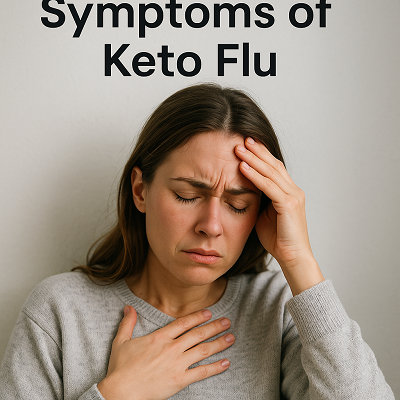
Trying the keto diet for the first time comes with a decent learning curve. While some people slide right into ketosis and feel pretty good, others hit a wall known as the “keto flu.” It’s a group of symptoms that can feel a lot like you’re getting sick-tired, achy, moody, and even foggy headed. The tricky part? It usually pops up in the first week or two just as your body’s adjusting to burning fat instead of carbs.
If you’re reading this, maybe you’re feeling awful, searching for answers, and wondering what the quickest fixes actually work. No need to panic. I’ve been there and the great news is there’s a lot you can do to get over the worst of it fast. This 2025 guide covers the fastest actions, practical hacks, and some science to help you beat the keto flu and stick with your goals. Whether you want weight loss, better energy, or to feel in control of your diet for the first time, there are real solutions.
Ready for relief? Here’s my full breakdown on how to beat keto flu fast. No nonsense, no hype, just what’s worked for me and so many others who faced the keto flu.
Table of Contents
Understanding Keto Flu: What Is It and Why Does It Happen?
How to Start the Keto Diet (2025 Beginner’s Guide)-Lose Fat Fast & Stay in Ketosis
Keto flu isn’t a real flu. It’s a nickname for how your body reacts when you first switch to a ketogenic diet. By suddenly cutting carbs (sometimes from hundreds of grams a day down to 20-50g), your body starts burning stored fat for energy. This transition can cause a temporary drop in energy, mood swings, and some pretty weird symptoms, like muscle cramps or brain fog.
Common Keto Flu Symptoms

- Exhaustion or heavy fatigue
- Headaches
- Mood swings or irritability
- Muscle cramps or weakness
- Brain fog or trouble focusing
- Upset stomach or nausea
- Difficulty sleeping
- Feeling dizzy or lightheaded
- Cognitive & Focus
Most of these hit because your body is losing water and electrolytes as you stop eating carbs. You’re also learning to burn fat for energy, which takes a few days to really kick in. This period can last anywhere from a day or two up to a week, but there are ways to shorten it dramatically.
Step 1: Nail Your Hydration Immediately
Water loss is the sneaky cause behind so many keto flu symptoms. When you eat fewer carbs, your body stores less water and you start peeing away sodium, potassium, and magnesium, a triple threat for feeling rundown.
How to Rehydrate Smartly
- Drink 12-16 cups of water per day during your first week on keto. If you’re thirsty or have headaches, try even more (safely, of course).
- Add electrolytes back in. Try mixing a pinch of salt into water (or a sugar free electrolyte powder) 1-2 times a day.
- Add potassium and magnesium. Green leafy veggies, avocado, and some nuts help, but a supplement is worth considering if you’re struggling.
Getting your fluids and minerals back up can make a dramatic difference, easing symptoms within just hours, especially headaches, muscle cramps, and the so-called brain fog. Many people underestimate how much water they need, so keeping a water bottle at your side and sipping throughout the day helps you keep this habit consistent.
Step 2: Boost Your Electrolytes the Smart Way
Electrolyte loss is probably the most overlooked part of why people feel so blah on keto. Here’s how to get your sodium, potassium, and magnesium back on track.
- Sodium: Aim for at least 2000-4000mg daily. That’s about one full teaspoon of table salt, split into servings. Broth or bouillon cubes are super helpful (especially chicken or bone broth). Don’t stress about being too precise. The goal is to stop headaches, fatigue, and muscle cramps.
- Potassium: Try eating an avocado, some spinach, or mushrooms each day. Supplements are available, but check with a doctor first since too much can affect your heart rhythm.
- Magnesium: Consider a supplement of 200-400mg each night. It can also calm jittery legs and help you sleep.
For a lot of folks, simply adding a daily cup of salty broth wipes out the flu symptoms. If you exercise heavily or sweat a lot, you may need even more. Track your intake, especially on hot days or after workouts. It’s wise to check with your healthcare provider before making big supplement changes, but most people feel real improvement within a day or so. Remember, sodium isn’t the enemy here, and it can take a few days to restore your normal balance if you’ve been low on salts for a while.
Step 3: Don’t Go Too Low on Calories
Top 7 Keto Meal Plans That Melt Fat Fast (2025 Edition)
It’s tempting to try to lose weight as fast as possible when you start keto, but dropping calories too much at the same time you cut carbs sends your body into shock. That makes keto flu symptoms worse and drags out the recovery.
Stick close to your normal calorie needs, at least for the first week or two. You’ll naturally eat less over time, but the goal is to support your metabolism while it re-learns how to burn fat. For most people, this means eating until satisfied and not stressing about strict limits right away.
How to Know You’re Eating Enough
- You feel “full” and not starving after meals
- You’re not waking up hungry in the night
- Your energy stays pretty stable through the day
Getting enough food helps your body make ketones and speeds up the fat adaptation process. Consider using a food tracker app for the first week to see where your calories fall. When in doubt, focus on whole foods: eggs, meats, fish, avocados, nuts, lowcarb dairy, and plenty of olive oil or butter to round out meals.
Step 4: Ease Up on Intense Workouts (Temporarily)
While regular exercise is awesome for health and supports ketosis in the long run, super intense workouts during the first days on keto can make flu symptoms worse. Your body is still adapting, so it’s better to go for easy walks, gentle yoga, or light stretching until you’re through the rough patch.
Once your energy is back (usually after a week or less), it’s fine to ramp things up. You’ll probably find that your stamina improves as your body switches into fat burning mode. Some athletes on keto notice even steadier energy after adaptation. The key is to listen to your body and avoid overdoing it in these crucial first days.
Step 5: Prioritize Sleep and Rest

Lack of sleep makes keto flu feel a hundred times worse. Your body needs time to adjust, and good sleep is the best way to help it recover. When you start keto, the stress of change can make sleep patterns worse at first, so be patient and try to keep healthy routines.
Simple Ways to Get Better Sleep
- Go to bed and wake up at roughly the same times every day (even weekends).
- Use blackout curtains or a sleep mask if the room is bright.
- Avoid caffeine after lunchtime to help your body wind down.
- Take a hot shower or bath before bedtime to relax muscles and drop your body temperature naturally.
If sleep is really elusive, some people find that taking magnesium at night helps their brain settle down. Stress management during the day, like meditation or deep breathing, can also give your mind a rest and help with sleep quality at night.
Step 6: Gradually Cut Carbs Instead of Going Cold Turkey
If you’re reading this before officially starting keto, one of the best ways to dodge the really rough flu symptoms is to taper your carb intake over several days or weeks. Instead of slashing straight to 20g net carbs, try 100g for a few days, then 70g, then 50g, and drop to your full keto level. This gradual approach allows both your body and mind to adjust.
This “ramping down” gives your body more time to adjust, making the switch a lot smoother for most folks. Tracking your carbs with an app or food journal can help keep progress on track and make the changes feel less drastic.
Step 7: Eat Plenty of Healthy Fats
Your energy needs to come from somewhere, and with carbs out of the picture, healthy fats fill the gap. If you’re just eating a lowcarb, lowfat diet, you’re guaranteed to feel awful. Adding enough fat takes the edge off cravings and hunger, and is essential for your brain, hormones, and mood during those first tough days.
Ideas for Easy Fats on Keto
- Olive oil and avocado oil drizzled on salads or veggies
- Real butter or ghee (great on steamed veggies or eggs)
- Coconut milk or coconut cream in coffee or smoothies
- Nuts, seeds, and nut butters (just watch the portions)
- Fatty cuts of meat and oily fish
Don’t be scared of fat here; it’ll keep you full, maintain energy, and help your brain adjust during your first keto days. Try to include fat at every meal, and don’t shy away from adding extra olive oil or avocado to meals for satiety.
Step 8: Use Smart Supplements (If Needed)
Most people can beat the keto flu with food and hydration alone, but a few supplements can make things way easier:
- Electrolyte powders or tablets: Quick way to top up sodium, magnesium, and potassium. Pick a sugarfree brand.
- Exogenous ketones: Some find a serving or two perks up energy and mental focus during the rough adaptation period. It’s not mandatory, but worth trying if you’re desperate for relief.
- Medium Chain Triglyceride (MCT) oil: Extra easy for your body to turn into fuel and good for an energy boost. Try a tablespoon blended into coffee or smoothies.
Always read labels and start slow to see how your body reacts, especially if you’ve got medical conditions or are on medication. Supplements are just helpers; the basics of hydration, salt, and enough food are the real game changers for most people.
Quick Reference: Fast Keto Flu Relief Checklist
- Drink plenty of water with added salt or electrolytes
- Eat enough fat and calories (don’t combine keto with a major calorie cut at first)
- Taper workouts to gentle movement only until energy returns
- Prioritize sleep, darken your bedroom, and keep a consistent schedule
- Taper carbs gradually if possible
- Try electrolyte supplements, exogenous ketones, or MCT oil for a shortterm boost
- Get help if symptoms are unusually severe, last longer than a week, or you’re feeling faint
Adjusting comes down to being patient and consistent with these core tips. Over time, you’ll not only dodge the keto flu but feel steady energy and focus as your body adapts.
Common Questions & Troubleshooting
I still feel horrible! Is it really just the keto flu?
Most people are back to normal (or better!) within 2-7 days. If you’re feeling worse or your symptoms get scary (like passing out, confusion, extreme muscle weakness), check with a doctor. Sometimes it can be a real illness or an underlying health issue showing up.
Can I take painkillers for headache or body aches?
Basic over the counter pain relief like acetaminophen or ibuprofen is usually safe for short-term use, just check with your healthcare provider (especially if you have liver, kidney, or stomach issues).
What foods should I absolutely avoid during keto flu?
- Sugary drinks (they defeat the point of starting keto)
- Processed “lowcarb” snacks with sugar alcohols (these sometimes upset your stomach)
- Really high fiber, non-keto veggies right out of the gate (they can cause bloating)
What if I keep getting keto flu every time I restart the diet?
If you stop and start keto a lot, symptoms can return. Tapering your carbs more gradually the next time helps, and so does keeping electrolytes and hydration front and center from day one. Planning ahead and learning what works for your body each time makes the process go smoother and reduces the “flu” duration.
Action Plan: Beat Keto Flu and Stay on Track
- Start each day with a glass of water with a pinch of salt (or an electrolyte packet).
- Make sure every meal includes healthy fats-don’t go low on calories when starting out.
- Pause on intense workouts; easy walks work best for now.
- Get to bed early and make your sleeping space as dark as possible.
- As energy returns, slowly ramp up activity and cut calories if you want to speed up weight loss.
- If symptoms stick around, recheck your hydration, salt, and supplement routine.
Starting keto isn’t just about discipline. Having the right info spares a lot of misery. Stay hydrated, eat well, and rest up. You can get through the keto flu days way faster than you might expect. If you want to learn more about ketofriendly recipes, tips for longterm results, or adjustments for special diets, check out resources from Diet Doctor or the Healthline Keto Flu Guide for extra reading.
Ultimately, the real key is to listen to your body, be gentle with yourself, and remember that even if you hit a rough patch, relief is just a few smart changes away. Many people who push through the first challenging week find their energy, mental clarity, and mood skyrocket once ketosis fully sets in. Don’t give up too soon-your goals, health, and well-being are worth it.
Written and published by:
Gabriel Rivera


Thank you for the incredibly clear, step-by-step guide it’s exactly what someone battling keto flu needs when their energy and focus are low. I especially appreciated the hydration and electrolyte sections. It’s easy to overlook just how much sodium, potassium, and magnesium matter when transitioning into ketosis, and your breakdown made it so approachable. The idea of starting each day with water and salt is such a simple yet powerful fix. I also loved the reminder not to go too low on calories early on so many people assume faster is better, but that tip can make a huge difference. Are there signs that help you know when you’ve fully adapted to ketosis? And for people who travel often, how would you recommend managing electrolytes and hydration on the go?
Thanks a lot, Ravin — I really appreciate that! You nailed it; hydration and electrolyte balance are huge parts of staying on track with keto, especially during the adjustment phase. Once your energy levels feel steady and cravings fade, that’s usually a good sign you’re fully adapted. For travel, I always recommend electrolyte packets or keto-friendly mineral drops—they’re quick and easy on the go!
Great post, Gabriel! This guide is one of the most thorough and practical breakdowns of keto flu relief I’ve seen in 2025. You really nailed how frustrating those first few days can feel and, more importantly, how to fix it fast without guesswork. The emphasis on hydration, electrolytes, and easing into workouts is spot on—so many people overlook those basics and end up quitting early. I especially like that you included smart, realistic steps like gradually cutting carbs and not slashing calories right away. The quick reference checklist is gold for anyone in the middle of keto flu and just needs clear direction. This is a perfect balance of science, personal experience, and actionable advice. Definitely sharing this with a few friends starting keto—it’s exactly what I wish I’d read when I first began!
Thanks so much, Andrejs – I really appreciate that!
You’re absolutely right – those first few days of keto can hit hard if hydration and electrolytes aren’t dialed in. I wanted this guide to be something people could actually use day-to-day instead of just reading theory, so I’m glad the practical steps stood out to you. Gradual carb cuts and staying consistent with light workouts make a world of difference when beating the “keto flu.”
How long have you been doing keto yourself? Always cool hearing what’s worked best for others in that first transition phase.
This one really hits home. I remember when I first tried keto years ago, that “keto flu” phase absolutely wiped me out. The fatigue, headaches, brain fog… it felt like my body forgot how to function. What this article nails is that most of it comes down to hydration and electrolytes. Once I figured that out and started adding salt and magnesium back into my day, it was like flipping a switch, energy came back fast.
I also like how it emphasizes not cutting calories too hard right away. That’s such an underrated tip. So many people try to do all the things at once — low carb, low calorie, heavy workouts, and just burn themselves out. Slow adjustments really are the key.
Honestly, I wish I had read something like this back when I started. It’s a great reminder that keto success isn’t just about willpower; it’s about understanding how your body works and giving it what it needs to adapt.
Great insight, Jason! You nailed it electrolytes are a total game changer when it comes to getting through that dreaded keto flu. It’s amazing how something as simple as adding salt, magnesium, and potassium can completely shift your energy levels. I also agree about easing into keto instead of slashing calories right away slow adaptation always wins. Thanks for sharing your experience; it really helps others see that the “flu” doesn’t have to last long if you approach it smart. What kind of electrolyte sources do you usually rely on supplements, or more natural options like broth and sea salt?